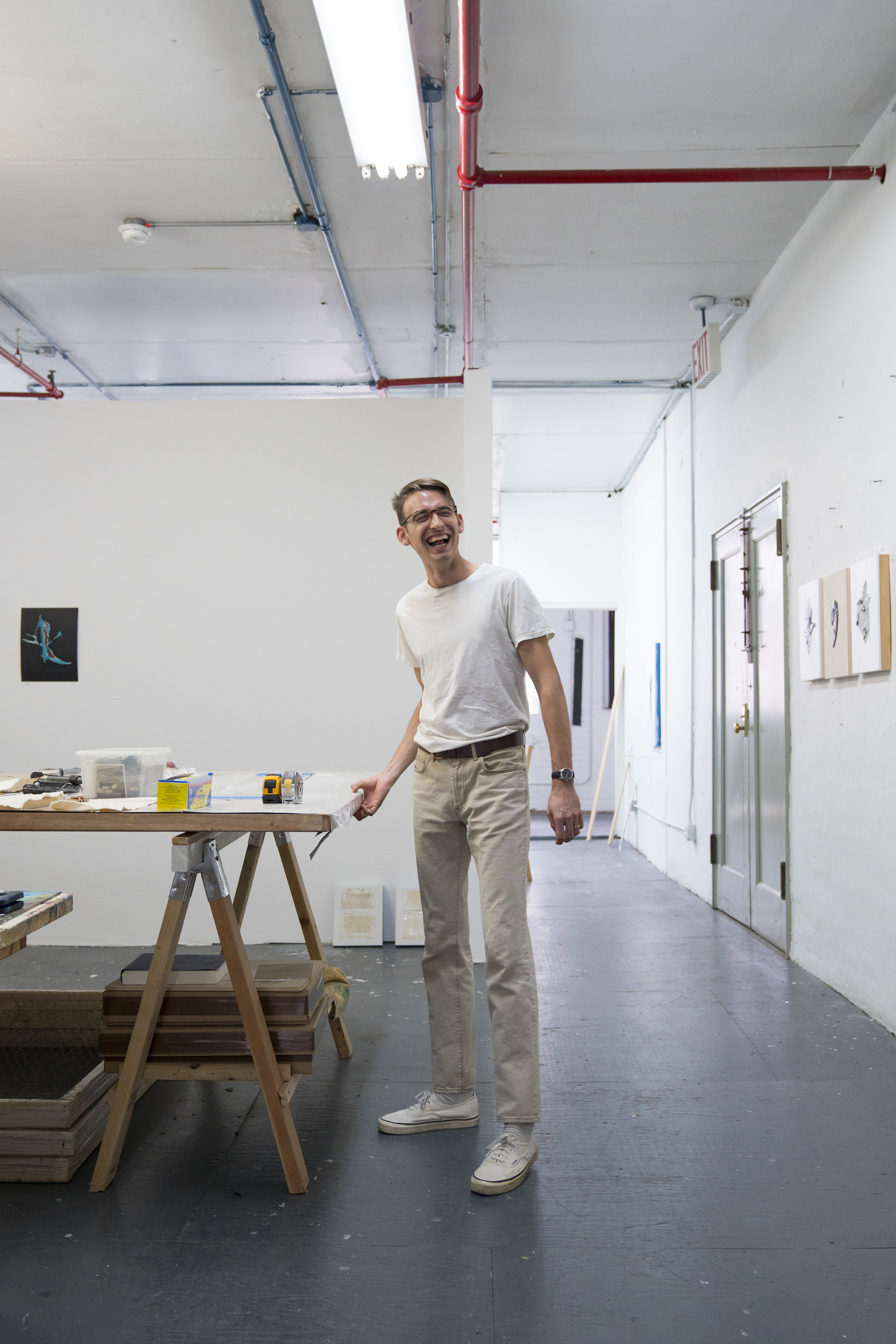
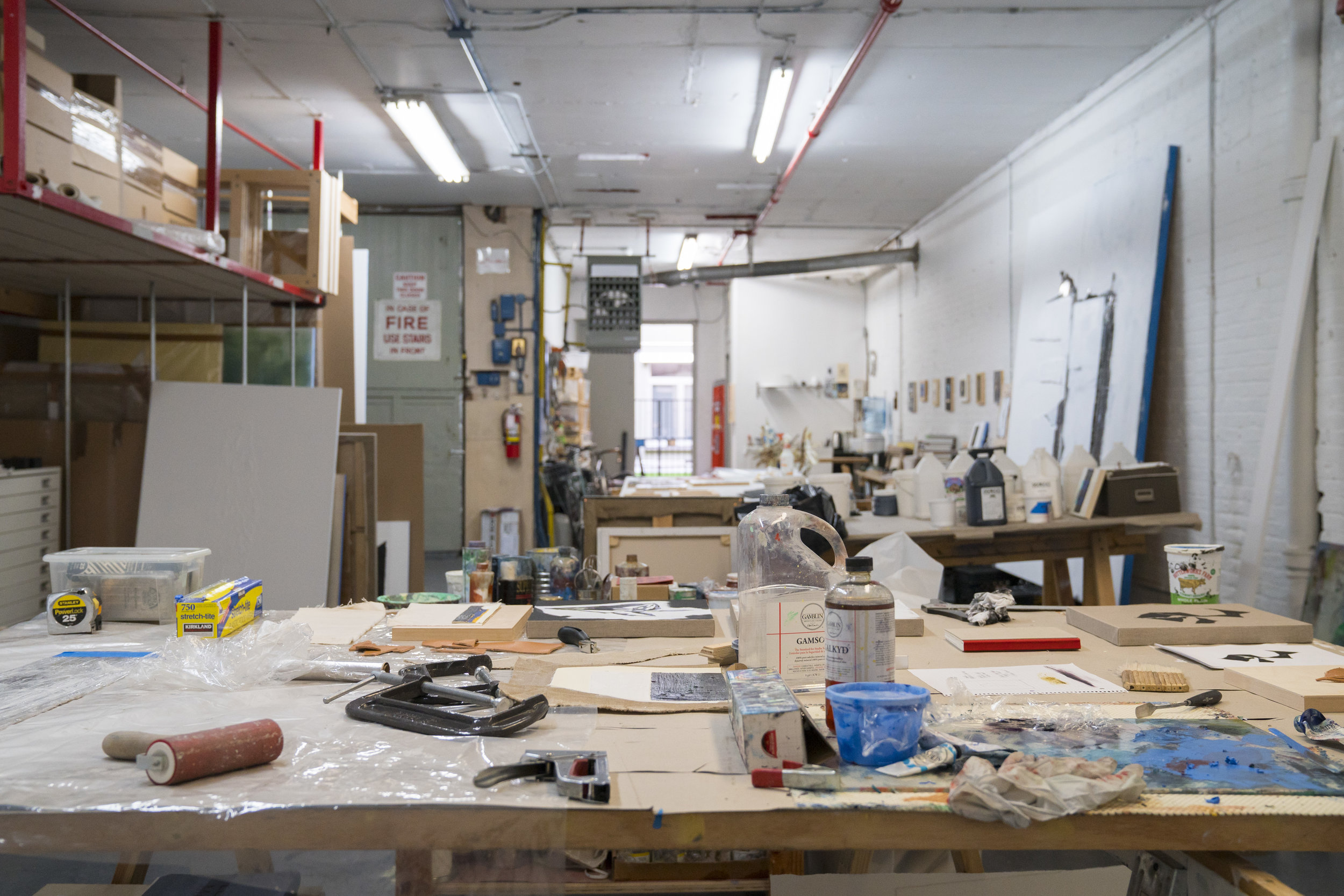
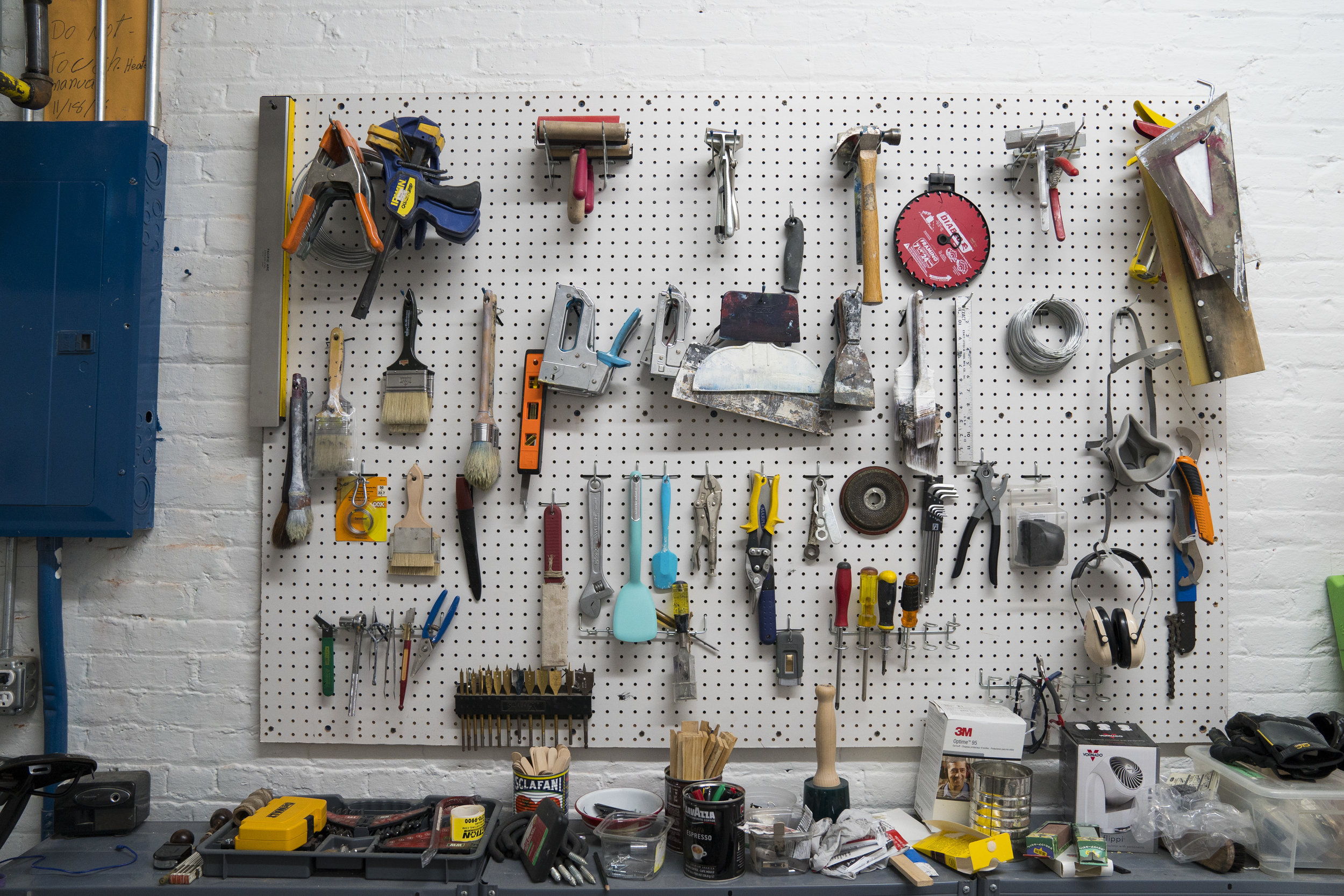
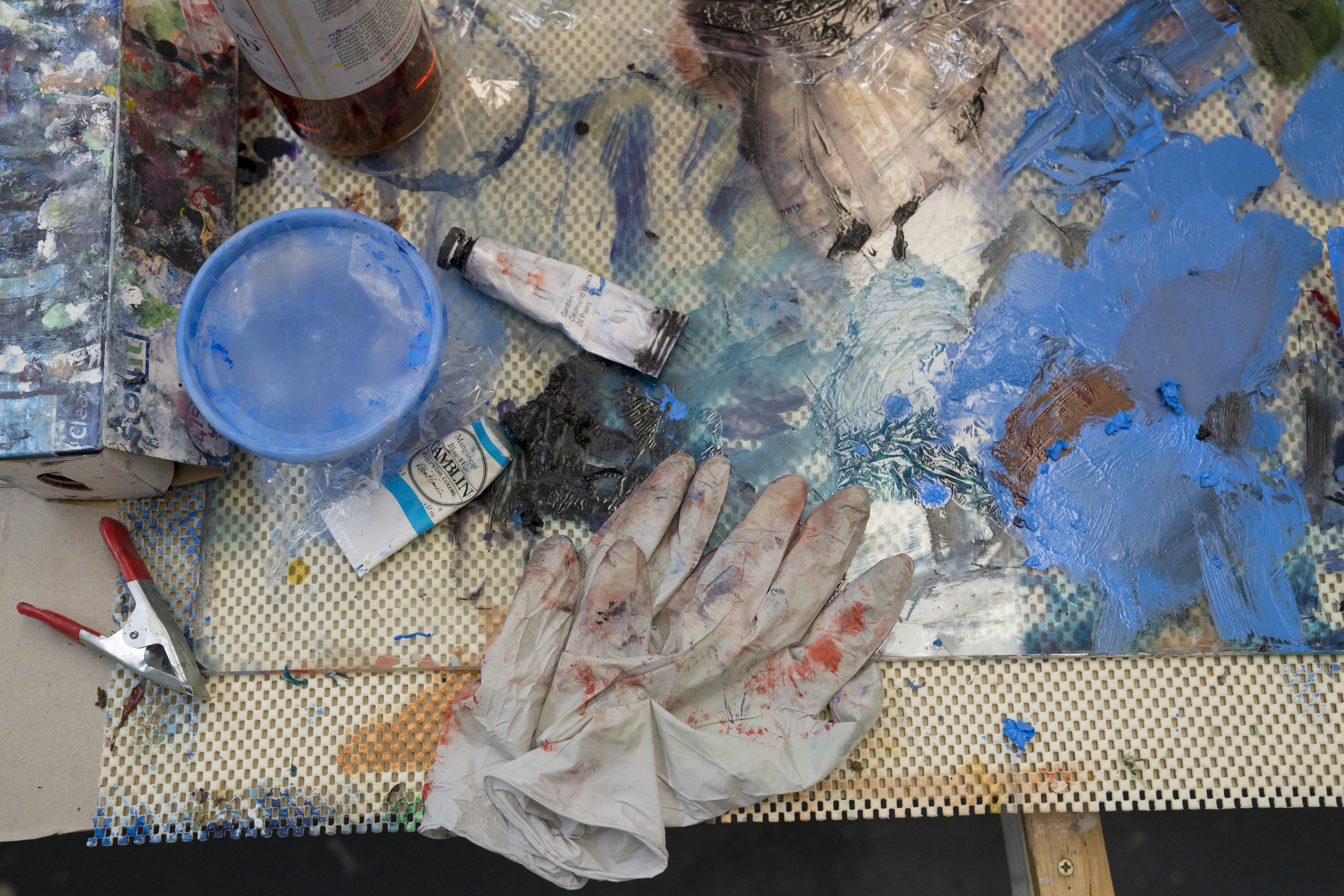
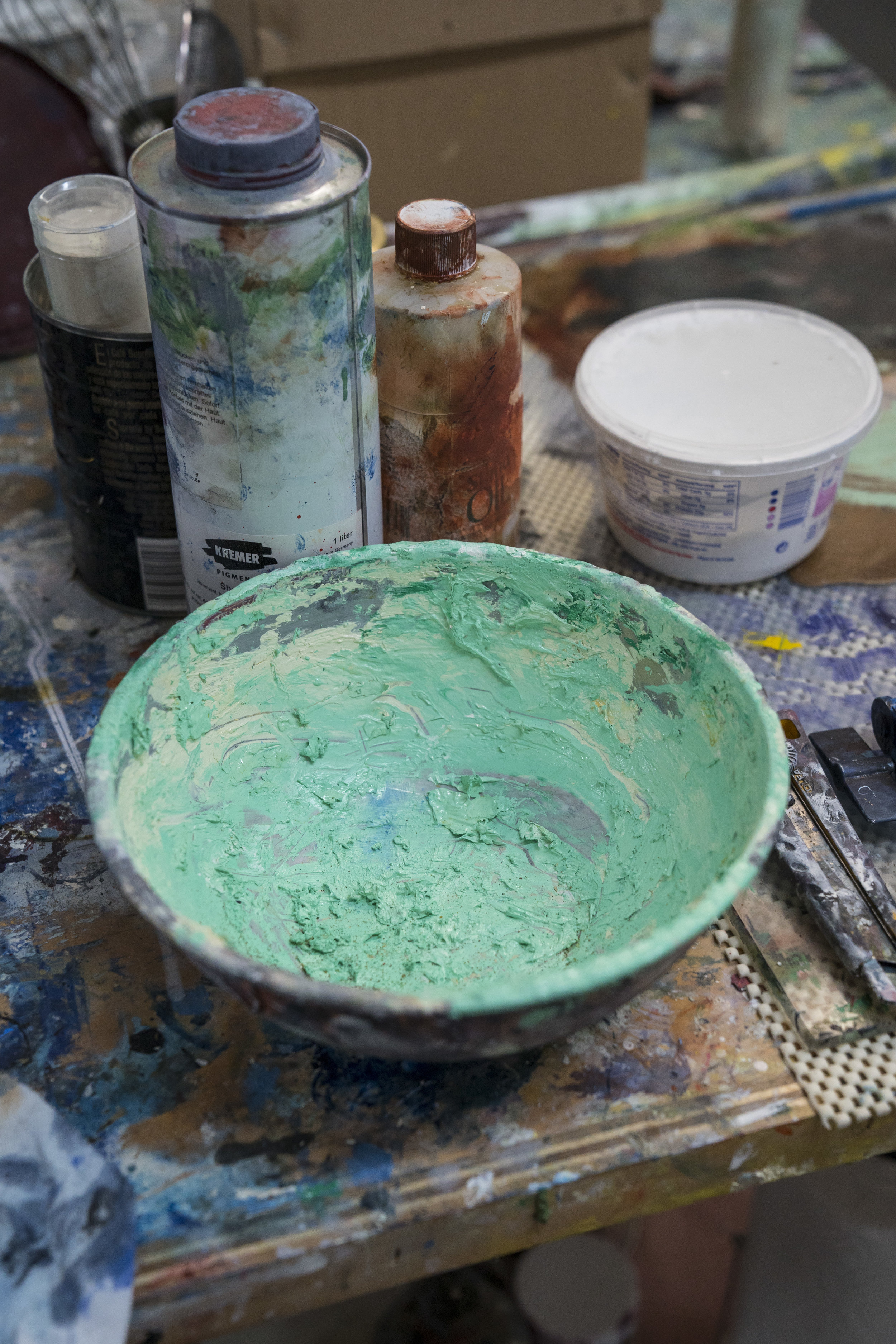
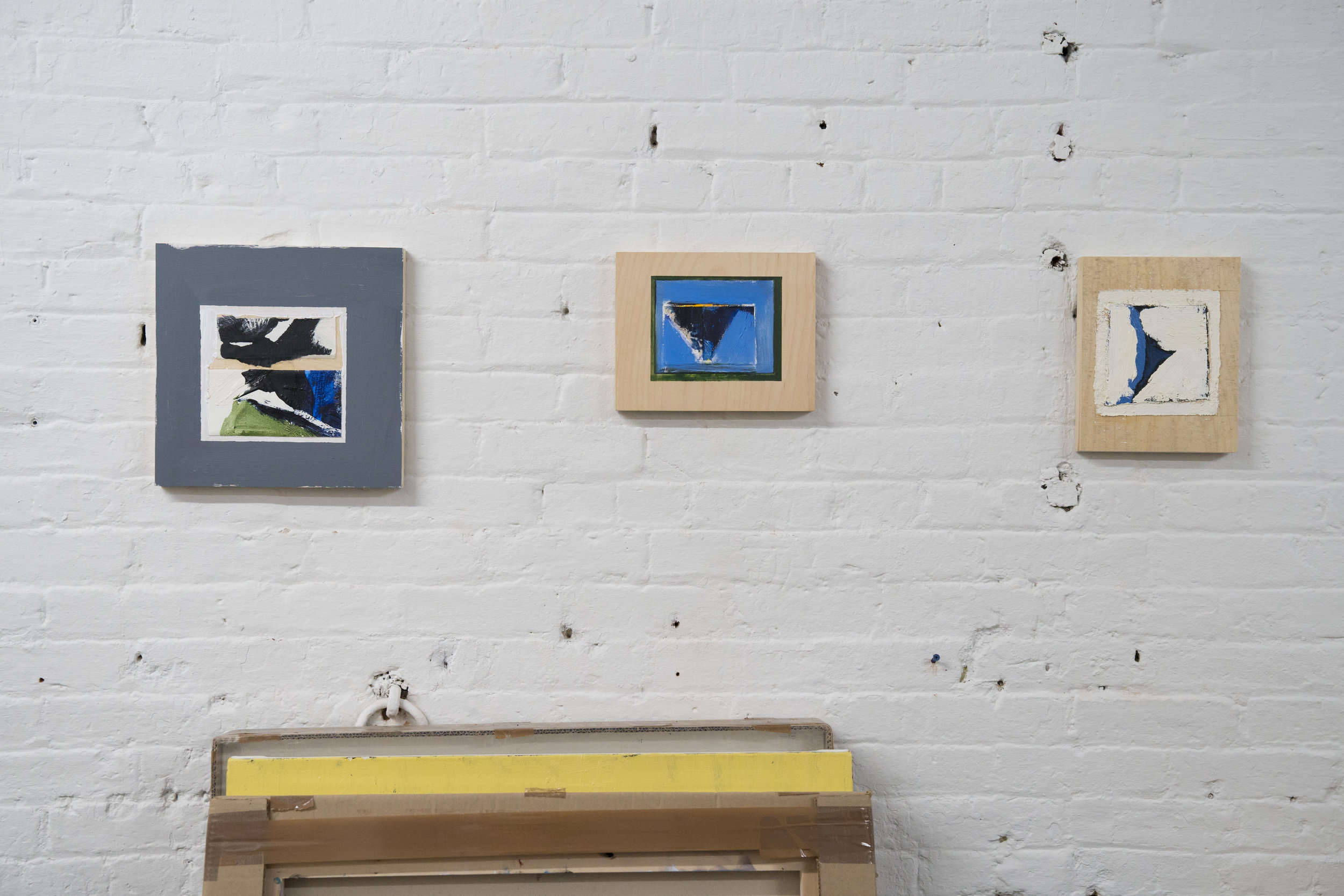
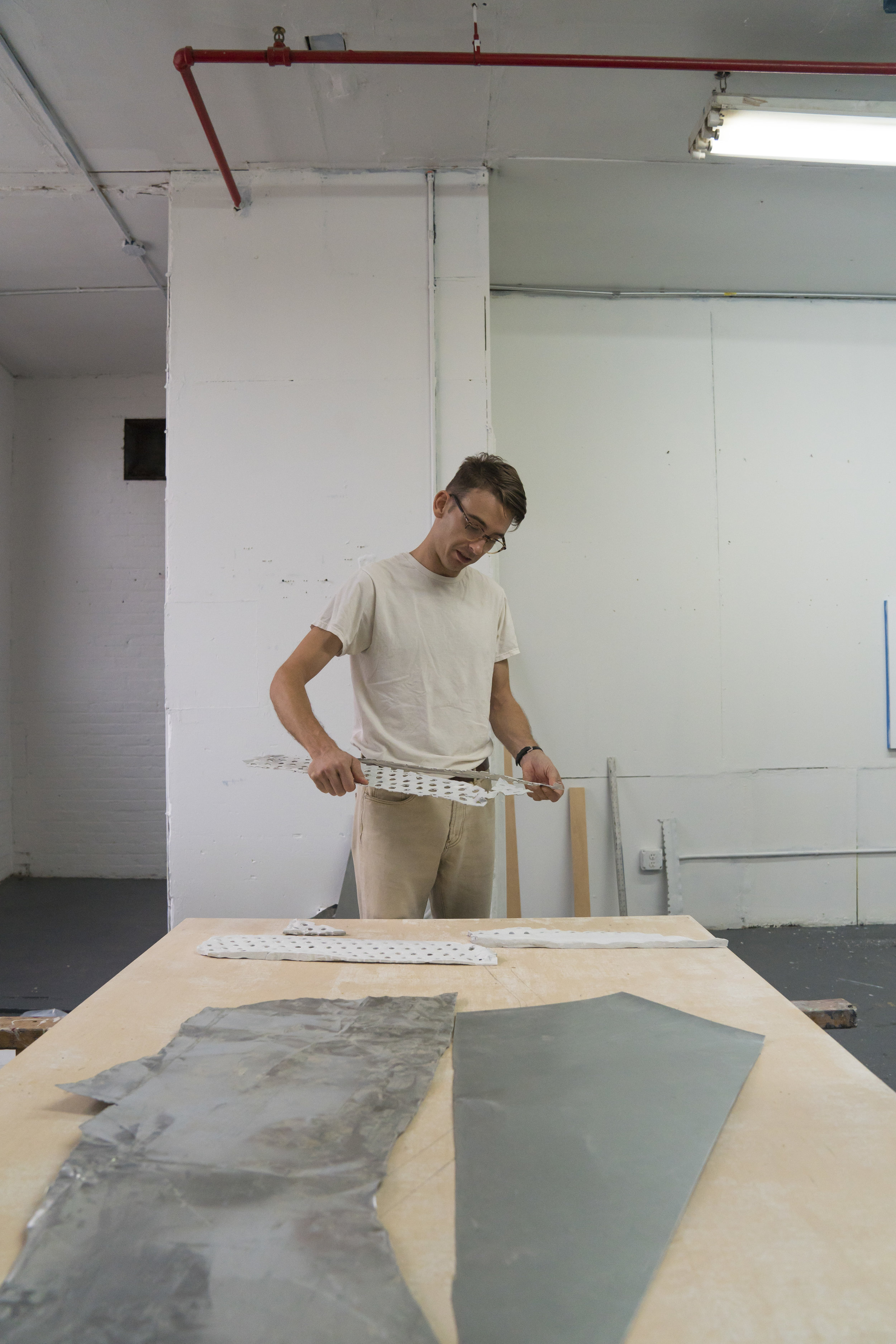
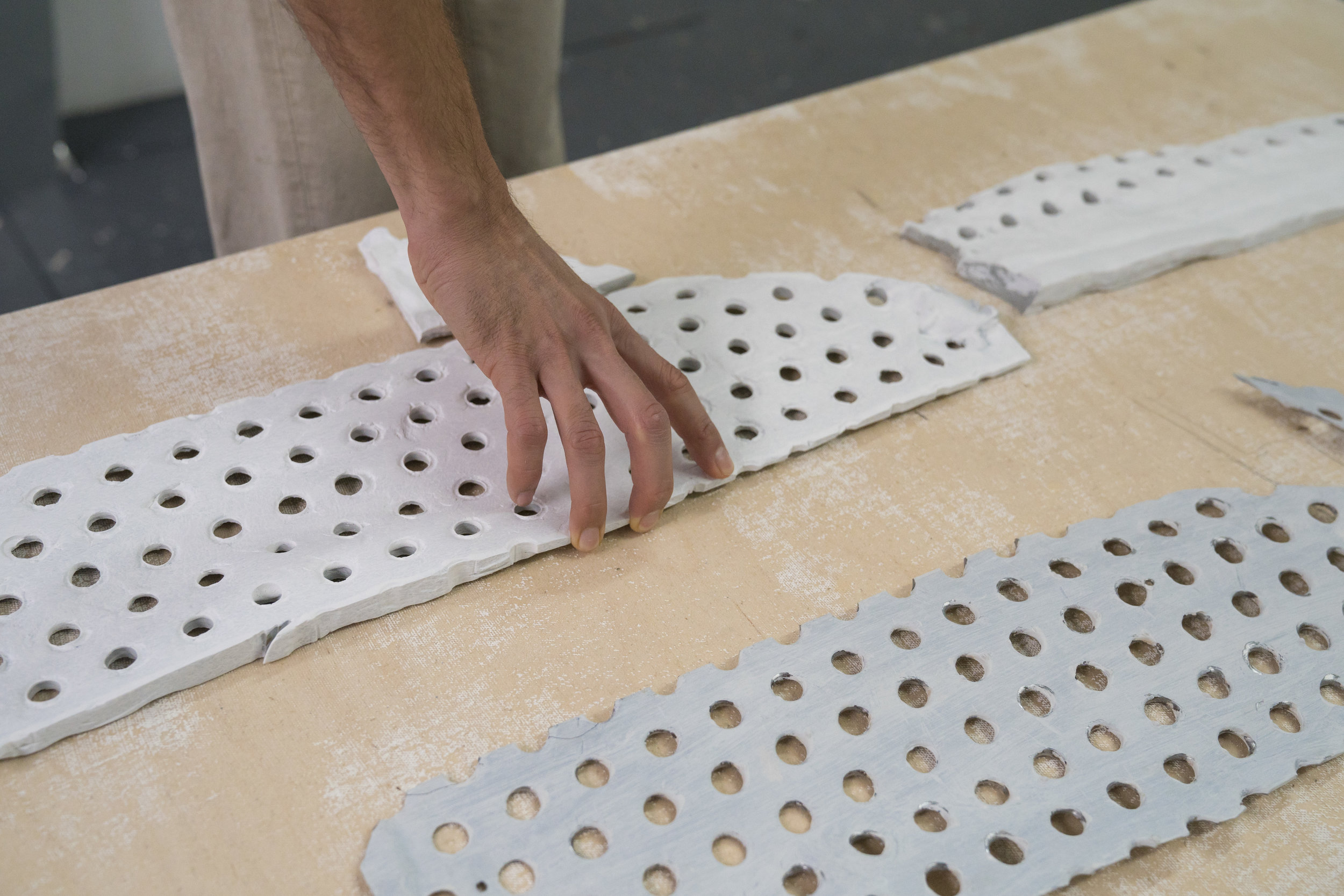
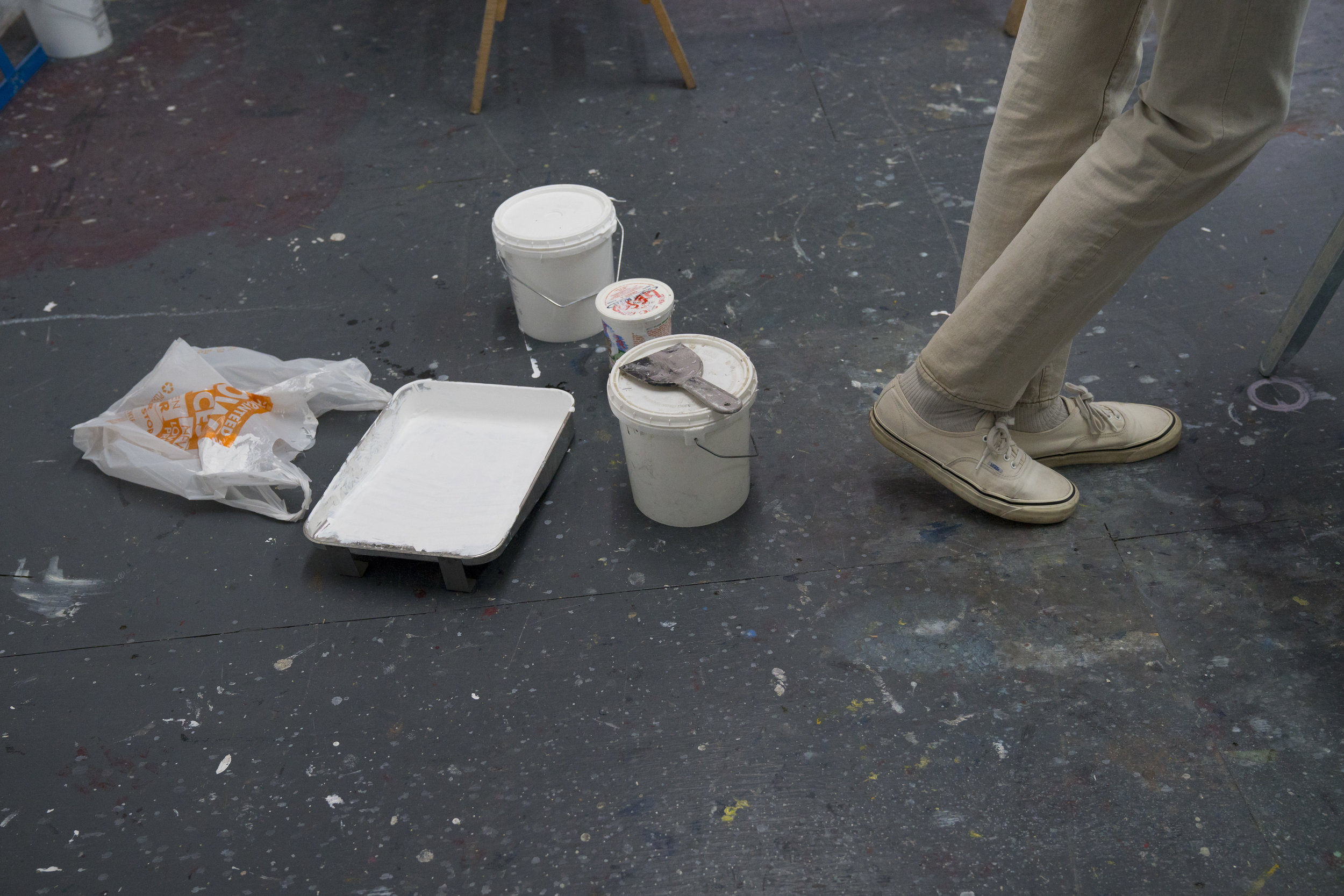
Erik Lindman
Who are you?
My name’s Erik Lindman. I’m a painter who is based in New York, and I grew up here. That’s about it.
What do you make?
The paintings that I make involve using found surfaces and integrating them as compositional elements. In terms of the process, the way that these different forms become images and not objects is part of how the artwork is made.
Do you have a preferred medium?
When I say that I’m an artist to family members or strangers, they ask me, “What kind?” And then I say, “I’m a painter.” Then they say, “What kind, representational or abstract?” And then I awkwardly pause because I don’t necessarily think that my work is abstract, but it does involve a language of historical abstraction. So then I say, “It’s abstract.” And then they generally ask, “Oils or acrylics?” which is not a term that any artist would really think in, but I generally respond, “Oils” or “Oil paint.” So I think the answer to the question is oil paint. I’m interested in oil paint because of its historical dimension. Recently I’ve enjoyed learning how to make my own. Oil paint has a very interesting materiality and it has a lot of limits based into it, which I think are productive. You can’t do everything with it, but you can still do a lot. I use other paints when it makes sense to use them, but I do have my preferences in oil paint because it embodies a lot of the things that I’m interested in that painting can do. It articulates my choices well.
Describe your workspace.
My home is very comfortable and ordered; I like putting things away and I don’t like leaving things out. But I do like leaving things out and having a messy studio. That being said, I still keep finished artwork here at the studio. I enjoy keeping it wrapped and ordered. That stays very orderly, but the workspace stays disordered. I don’t just sit and work on one painting at a time; I jump around between a lot of different works. I leave different things around because sometimes seeing one thing next to another leads to a new visual association, and I like having that. It’s nice to have a space where you can let things be as they are. So those are my ideas of a workspace; it’s a space to sit and look at stuff, and also to play and experiment with forms.
Under what conditions do you work best?
I rarely work on the weekends. Not as a rule, but I do think it’s nice to give myself space to not be working. During the week I’m not here 9 to 5; I’m probably here between 12 and 6. I like being alone. I had a really nice guy help me out in the studio a couple of years ago, but I found that it changed the work. Now I’d rather have some more space with myself and then know when it is necessary to get other people involved. It’s about knowing how to really own when it’s important to have someone fabricate something versus doing it yourself and what that means for the work. I’m not interested in work that has to do with the amount of sheer labor that it takes to make something; I think there’s enough labor in continuing to be an artist and in keeping working. That’s something I admire, people who can still make work after thirty or forty years. That’s more laborious than going to the studio day after day, getting a job, having a family… Just being alive and keeping working is enough labor, more than being impressed with the labor that it took someone to make something. But that may just be a set of aesthetics that I’m attracted to.
Do you have any rituals surrounding your practice?
I really like coffee and it’s a big part of my practice. That’s the first thing I do—I come in and I make coffee. Then I sit in the clothes that I came in wearing and I look at what I made the day before. There’s a space between my idea of what it was that I did and the new eyes that I bring to it, so there are a couple of seconds where it feels unfamiliar. And I sit with that. Then I change into my work clothes and work until I get some food. I have more coffee and work until it’s about evening, and then I stop. Coffee is the punctuation of the ritual, I think. In that same way, when I wake up I do draw at home. I draw a lot. I keep sketchbooks, not in some sort of artist's way of a mechanized practice of forced creativity. I just enjoy drawing. Those drawings are not directed towards anything, they’re not necessarily source material for other works, they’re just drawings.
Describe your process.
I don’t go out and look for stuff. I’ve never been interested in renting a pickup truck and going to a junkyard—yet. Often I’ll be walking to the studio and I’ll find something or pass a construction site and find a form or a shape. And then later when it’s at the studio there’s a process, like if it’s really rusty I want to remove the rust, or if it has a certain dimension I want to remove that dimension. And in the process of doing that a new form itself comes out. And that leads to other decisions, like if I have a piece of rubber or some plastic I have to decide how it gets adhered to the panels. The idea of working with panels has to do with rigid surfaces and an association with a tradition of icon paintings, images, and objects. So all that stuff gets wrapped up together with all of the decisions of the process. The physical things are joined, glued, screwed, and epoxyed together, which starts to weave a cascade of decisions that are important for all artists to articulate value, attention, and decision-making.
There’s always a level of unpredictability that I embrace in my work. I think it’s very hard to maintain enthusiasm after the initial excitement of a wonderful accident, but there’s a lot of creativity in maintaining that excitement without it becoming a trope or a prop or some kind of typology. It actually takes a lot of faith, because I don’t know what I’m going to find. There are maybe two or three things in the studio that I’m working with as found surfaces right now. People think that I have some storeroom of junk and I don’t, I never have. It’s just one thing at a time. So there’s a certain sense of visual problem-solving that it creates. Maybe the creativity has to do with the pliability of problem-solving skills that are practical and have a resonance intellectually.
What is the relationship between the support and the surface of your paintings?
There’s a certain visuality that happens in the paintings, it’s like they’re neither objects nor images—they’re both. There's a certain sense of visual space that isn’t fully denied and isn’t fully embraced. I don’t think of the paintings in terms of figure/ground. I don’t think that I would work with a found surface just floating in the world on its own. I join it with a panel, which is the “canvas,” not in terms of fabric but in terms of a conceptual framework. The historically-determined idea of painting that the work hangs its coat on allows the audience more accessibility, rather than it trying to devalue the authority of the traditional framework of canvas. So the artwork happens in the joining of the support and the surface, fairly actively, because otherwise it’s just stuff.
How do you instrumentalize color in your work, both visually and materially?
Color is a lot of different things. Pigment is a material physically. All of its elements are materials and have signification in and of themselves—not just as signifiers of value in terms of the archival nature of things. We think that we want everything to last a certain way, and that that’s better, but sometimes that’s not actually true. For instance certain monks living now that make illuminated manuscripts want to use pigments that are not lightfast and not archival, like pigments made from natural dyes and roots, boiled berries and stuff, even when there are permanent alternatives that are very similar chromatically. They want to use those pigments because of the idea that the pigments are created from god; they want the word to be created from god, not from an artificial pigment. I think that’s an interesting dimension to consider as a part of the process of making. So part of my investigation into making paintings is not necessarily to have to articulate that idea of the sanctity of the artwork, but at least to embrace the complexity of that discourse. I get to own it a little bit more as opposed to being subject to it.
What’s the process of titling your paintings?
I don’t want the titles to overtly dominate an associative image in the work, yet I find that it’s important to have the work be titled because it matches the consideration felt when a work feels finished. Deciding when the work is finished is a huge part of the artwork. That’s one of the tools of a painter in addition to a pigment or a brush or a stick. Saying when it’s done is a material in and of itself. I used to be able to say a painting is finished when it satisfies a certain level of conditions that I’m interested in for what a painting can and can’t do, but that’s a bit more academic than the truth. The truth is more complicated and nuanced and maybe cliché, it’s something that I’m comfortable with. So I wish to call all of my paintings Untitled, but I don’t want to because a name is important, it has an authority, it means that I cared about it enough to say that it’s done and I made it. It’s ridiculous—I’ve done it before. All of these paintings were called Untitled and my friend was writing about them and was like, “As you can see in Untitled, 2014...” And I was like no, I can’t see, because I don’t know which painting you’re talking about.
So the titles usually come after the work is finished. I try and match something visual that I see in the work with a word iconographically so that I can remember and see what’s in the work. I don’t want to name something that’s associative or an action or name the process of the work. In the most recent body of work, I’ve mentioned a certain materiality that happens in the work and the colors of the work. A title may be Black and White or Green Metal Plate. Some people give my paintings nicknames. I do in the studio, and I think a lot of artists also do that. The nicknames won’t leave the studio though, like the “Chicken Painting.” Unfortunately a lot of the paintings look like states, so when they do I tend to alter the shape, otherwise it’s the “Delaware Painting.” Maybe I would actually call it that, just so I’d remember it.
What is the most challenging part of your process? Where do you find the most ease?
The most challenging part about being an artist is everything outside of the creative process that you don’t learn in school: how you relate to your gallery, how you relate to other artists, how you create a budget, how you don’t follow a budget, how you pay taxes. All the administrative stuff that you don’t want to think about at as an artist—or as an image of what an artist does—is behind everything. The good news is that all of that can be done by someone else. The thing that they can’t do is have the thought process that you have as an artist in and of yourself. So I’m grateful that I have that myself, even if all the other stuff can be challenging at times. There’s nothing about the way of thinking that I have that someone else can give or take away.
Does working in New York have an influence on your practice?
I think so, but it’s hard to see when I’m in it and when I’m doing it. I can only do that by thinking negatively through comparison to other artists who work in other cities. A lot of artists who I know that have moved to California end up working with a certain level of fabrication, which is related to the accessibility of that due to the automotive and movie industries out there, and also to the historical conditions of the light and space artists and conceptual artists who framed the academic discourse there. We don’t have that out here. But growing up I did spend a lot of time looking at museums and galleries. I’ve never lived anywhere else or gone to school outside of New York, so I think there are certain things that I take for granted that I have grown to accept as a kind of given. Like I think my interest in traditional painting comes from spending a lot of time actually looking at paintings in person, and I don’t think I would’ve had that experience if I wasn’t in New York. Being able to go during the day, without having a plan, to see so much stuff that's really amazing is such a wonderful thing that I take for granted a lot. It’s a great thing that we have here.
Is there anyone or anything that inspires you?
I’m reading Go Tell It On the Mountain for the first time—Baldwin’s book. I think it is a really wonderful example of how craft, intuition, and personal experience can articulate political change without becoming a caricature of politics. That’s inspiring to me.
In what ways has your practice evolved over time?
I feel like I’ve become less rigid in terms of wanting to know what I’m doing in an intellectual way, or feeling guilt and shame about not occupying a position of detached coolness.
How has your practice shaped your hands?
I love that question. That’s really sweet. My dad is a really good craftsman; he knows how to make things. He grew up in Sweden and learned how to do things himself. Like if he and his brothers wanted to go see a friend in another town and didn’t want to walk, they had to learn how to get there by making a bicycle. Then after they got a little older, if they wanted to get there faster, they learned how to make a car. And they didn’t have much money so they learned to fix things themselves. So my dad knows how to do things very well—he’s currently building his house pretty much by himself in Sweden. That being said, when I grew up here in New York, I didn’t have a garage and we didn’t have that stuff, so I learned how to fix things a lot myself. I feel like in the same way, even in that physical way, I’m learning how to make the paintings that I want to make. No one taught me how to make a painting with a found piece of metal or a found piece of rubber and oil paint or how to make my own pigments; I’ve had to learn that myself. In that process of discovery, I feel like I’ve gotten a shared connection to the way that my dad figured out how to build cars and bicycles. I feel a really strong link there in terms of my relationship with him. I think that’s why it feels like a very touching idea to me.
Erik Lindman in New York, New York on October 21, 2017. Photographs by Julia Girardoni.
